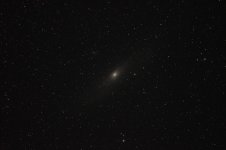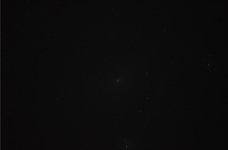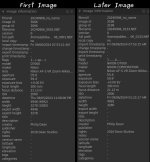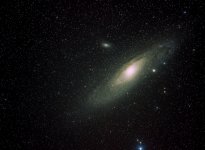PhilD41
New member
Hey everyone,
I am hoping someone here has more experience in this than I do. I am helping my son set up my D7000 for long exposure, deep sky photography. We have not had any issue using the interval timing with the built in 30' shutter speed using 34' intervals. In fact we captured about 6 hours of images this way the other night. Last night we set it up in bulb mode and configured the tracking mount (Star Adventurer 2i) to trigger continual 60' exposures through it's SNAP interface connected to the remote shutter port on the camera. That worked as expected, at least with the number and timing of photos. However, the photos progressively became darker and darker pretty quick after the start. Meaning we didn't get but 15 or 20 usable images over the 7 hours. Below is a screen shot from DarkTable showing the thumbnails of the images. You can see the galaxy in the top left corner image (bright, smudgy spot). By the time it get to the lower left image the starts are almost not visible and the galaxy is reduced to a faint dot. The images never go completely black, though, but fairly close. I also capture the EXIF data for one of the images. That EXIF data all looks correct to me.
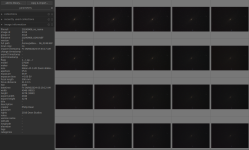
My initial thought was a fading issue with the sensor with continual long exposures. As the sun came up the next morning, the images slowly moved from black to blue to white as I would expect with that exposure time. From what I can tell, the camera is fulling operational this morning with nothing amiss other than the photos it took overnight. Any help or ideas on this would be greatly appreciated.
Grace & Peace!
I am hoping someone here has more experience in this than I do. I am helping my son set up my D7000 for long exposure, deep sky photography. We have not had any issue using the interval timing with the built in 30' shutter speed using 34' intervals. In fact we captured about 6 hours of images this way the other night. Last night we set it up in bulb mode and configured the tracking mount (Star Adventurer 2i) to trigger continual 60' exposures through it's SNAP interface connected to the remote shutter port on the camera. That worked as expected, at least with the number and timing of photos. However, the photos progressively became darker and darker pretty quick after the start. Meaning we didn't get but 15 or 20 usable images over the 7 hours. Below is a screen shot from DarkTable showing the thumbnails of the images. You can see the galaxy in the top left corner image (bright, smudgy spot). By the time it get to the lower left image the starts are almost not visible and the galaxy is reduced to a faint dot. The images never go completely black, though, but fairly close. I also capture the EXIF data for one of the images. That EXIF data all looks correct to me.

My initial thought was a fading issue with the sensor with continual long exposures. As the sun came up the next morning, the images slowly moved from black to blue to white as I would expect with that exposure time. From what I can tell, the camera is fulling operational this morning with nothing amiss other than the photos it took overnight. Any help or ideas on this would be greatly appreciated.
Grace & Peace!

